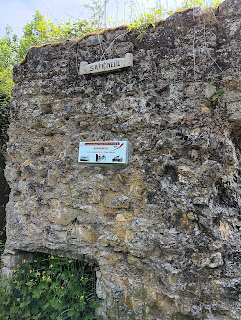We headed north on Wednesday, May 10, and it was a mere 4 kilometers to the confluence with the Aisne River and new cruising territory for us. We had a bit of difficulty accessing the first lock on the Aisne, because there was no one in the control booth, no answer to our vhf hails, and the lock phone number in our cruising guide was incorrect. I finally managed to make contact with someone in a centralized vnf office, and two phone calls later someone showed up to let us into the lock and give us a telecommande device for operating the locks further along the river.
And then it began to rain, earlier in the day than predicted (of course!) We were already driving from inside, because it had been too gray, cool, and damp to be comfortable on the flybridge. It's a good thing I had decent foul weather gear.
 |
| Going through locks in the rain--what fun! |
 |
| The Chateau of Vic-sur-Aisne. Earliest records were from the 7th century, but rebuilt often over the centuries. It is now a wedding and events venue. |
 |
| The rainy day gave way to a perfectly still evening, and river water like a mirror. |
On Thursday, May 11, we finally had a dry morning for cruising, but it was still chilly enough that we did our driving from inside. By lunchtime we were moored in the town of Soissons. Its roots go back to Roman times, and by the early Middle Ages it was a royal town, chosen as the capitol city of the Merovingians by Clovis, King of the Franks. Abbeys seem to have been everywhere--there were remnants of at least a half dozen in Soissons by my count. (The French Revolution in particular was not kind to abbeys and churches, hence, the "remnants".) Soissons was 80-90% destroyed in WWI, and although much of the rebuilding was done in Art Deco style, some of the medieval character remains in the paved streets and the Gothic cathedral.
 |
| Just us on a long stretch of mooring quay. I suspect it's a bit busier in the summer. |
 |
| The cathedral in 1918. |
 |
| The single tower of Soissons cathedral. Scaffolding was everywhere, inside and out. |
 |
| And this is all that is left of Notre Dame abbey after the revolutionaries were through with it. |
 |
| The shopping area of Soissons looked healthier than what we've seen in many other towns. |
We spent the full day Friday in Soissons, and unfortunately, the rain moved back in. But the silver lining was that the town was apparently big enough to show the occasional English-language movie in the local theater. We spent the afternoon enjoying "The Lost King", a British biographical film about the search for the burial site of Richard III, and the ultimate discovery of his body under a Leicester car park.
 |
| We passed through an area that was a graveyard for old wooden barges. |
 |
| It was wonderful to occasionally not be hemmed in by trees along the canal banks. |
Our stopping point for the day was the village of Bourg-et-Comin, at the junction of the Aisne lateral canal with a canal from the north, the Canal de l'Oise a l'Aisne. The village was rather quiet this Saturday afternoon, but our stroll around town showed us that it had all of the requisite elements of French villages:
 |
| The old railway station, before trains stopped coming to Bourg-et-Comin. |
The best discovery of the afternoon was finding a boulangerie (bakery) and tea shop that served absolutely delicious desserts.
 |
| Lon absolutely loved his chocolate-filled eclair. |
And that brings us to where we arrived yesterday (May 14) and spent the day today, Berry-au-Bac. Aside from one lock we will go through when we first start cruising tomorrow, we are done with the Aisne River (and canal) portion of our cruise. Berry-au-Bac is at the junction with the Canal de l'Aisne a la Marne, and we will enter that canal and start cruising south.
 |
| The French national cemetery in Berry-au-Bac, and the grave of the one Belgian soldier interred there. |
 |
| Biking along the Aisne-Marne canal. |
 |
| When you don't know what to serve for supper, be thankful for the roadside pizza vending machine. |
 |
| A memorial to the hamlet of Sapigneul, utterly destroyed in a battle for control of Hill 108 in 1917, and never rebuilt. |
 |
| Because the first French tank battle was at Berry-au-Bac, it became the site of the National Tank Memorial. |
As we've travelled the Aisne waterways, we've been just south of sites important to the battles of Chemin des Dames, a French offensive effort in 1917. The weather and the spread-out nature of the sites has kept us from visiting them, but we intend to stay a few days at our next destination, Reims, and may rent a car there so that we can better investigate that sorry chapter of French military history.
 |
| Champagne is big business in this part of the world. |
I don't know whether to believe it or not, but there is no rain in the forecast for the next several days. It's not going to be especially warm, but we'll take what we can get.









No comments:
Post a Comment